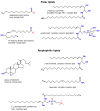The Meibomian puzzle: combining pieces together
- PMID: 19660571
- PMCID: PMC2783885
- DOI: 10.1016/j.preteyeres.2009.07.002
The Meibomian puzzle: combining pieces together
Abstract
The purpose of this review was to summarize the available information on lipidomic analysis of human meibum and tear film, and critically evaluate the pertinent past and present analytical procedures and results obtained in various laboratories. Human meibum was shown to be a very complex mixture of lipids of various classes. For decades, their exact structures have remained elusive. Because of the limitations of the then-current techniques, most of the complex lipids that constitute meibum could not be analyzed as whole molecules and required prior hydrolysis and/or transesterification of the entire lipid pool. These procedures effectively made it very difficult, and often impossible, to reconstruct the complete structures of the original intact compounds, which prompted us to call this The Meibomian Puzzle. Modern techniques such as high-performance liquid chromatography in combination with mass spectrometry help in solving this puzzle by allowing a researcher to detect and analyze intact molecules of complex lipid compounds, even if present in extremely low concentrations. This current de-facto standard procedure in lipidomic analysis of natural lipids and their mixtures is compared with other experimental techniques such as nuclear magnetic resonance spectroscopy, infrared spectroscopy, gas chromatography, and thin layer chromatography, among the others. The results obtained by older techniques, and their limitations and deficiencies are discussed. It appears that some of the earlier findings did not withstand a scrupulous re-evaluation and need to be modified and/or corrected. The most intriguing development is the virtual absence in meibum of typical phospholipids - an important group of amphiphilic compounds whose role in the human tear film was thought to be to stabilize the entire tear film structure. Instead, another group of previously unidentified compounds, very long chain (O-acyl)-omega-hydroxy fatty acids, appears to be a stabilizing factor which might be related to tear film stability and deterioration. Thus, these compounds may become an important target in biochemistry and (patho)physiology of ocular surface and dry eye research.
Figures








References
-
- Oleamide. 2009. Retrieved 06/01/09, 2009, from http://en.wikipedia.org/wiki/Oleamide.
-
- oleamide.htm. 2009. Retrieved 06/01/09, 2009, from http://www.chemicalland21.com/arokorhi/specialtychem/perchem/OLEAMIDE.htm#.
-
- Storage and handling of lipids. 2009 . from http://www.avantilipids.com/index.php?option=com_content&view=article&id....
-
- Andrews JS. Human tear film lipids. I Composition of the principal non-polar component. Exp Eye Res. 1970;10:223–227. - PubMed
-
- Argueso P, Beuerman R, Bonini S, Butovich I, Dana R, Dartt D, Gamache D, Gipson IK, Ham B, Jumblatt M, Korb D, Kruse F, Ogawa Y, Paulsen F, Stern M, Sweeney DF, Tiffany J, Ubels J, Willcox M. Research in dry eye: report of the Research Subcommittee of the International Dry Eye WorkShop (2007) Ocul Surf. 2007;5:179–193. - PubMed
Publication types
MeSH terms
Substances
Grants and funding
LinkOut - more resources
Full Text Sources
Medical
Miscellaneous

